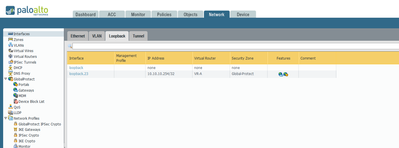- Access exclusive content
- Connect with peers
- Share your expertise
- Find support resources
Click Preferences to customize your cookie settings.
Unlock your full community experience!
Nominated Discussion: Dual ISP Global Protect Redundancy
- LIVEcommunity
- Articles
- General Articles
- Nominated Discussion: Dual ISP Global Protect Redundancy
- Subscribe to RSS Feed
- Mark as New
- Mark as Read
- Printer Friendly Page
- Mark as New
- Subscribe to RSS Feed
- Permalink
on 11-03-2022 10:23 AM - edited on 11-03-2022 10:24 AM by jforsythe
This article is based on a discussion, Dual ISP Global Protect Redundancy, posted by @DonohoeRobert. Thank you for the insight!
Hi Team,
I hope ye all are well. We recently worked a case for a customer that had dual ISP configuration and wanted the Palo Alto Networks device to provide redundancy for the Global Protect Portal and Gateways in the event one ISP went down. We came up with a handy way of providing this using NAT rules and a loopback and I am posting this to share with the community.
There are some screenshots from the lab below. Eth1/1 & Eth1/2 represent ISP-A and ISP-B.
We popped the Global Protect Portal and Gateway on a loopback interface.
We created two NAT rules to bounce the incoming traffic whether its from ISP-A or ISP-B to the loopback address.
The system has two Virtual Routers for both ISP's. VR-A and VR-B. VR-A has the loopback interface added.
Virtual Router B has a static route to VR-A which has a route to the loopback interface with the Portal and Gateway.
This simple setup allows access to the portal and gateway from either ISP interfaces. We simulated one ISP failing and changed the A record of the portal fqdn to resolve to the other interface and the users could connect without any input or changes from the end user. There are a number of ways to automate dns integrity and failover to resolve to a different ip address if it can't resolve to another. Beyond the scope of Palo Alto. Infoblox and Route 53 can provide these features. If you just have an MS server, changing the A record from one IP to another isn't a massive task.
Hope this helps few others and is nice way to provide an extra layer of redundancy for networks to big to fail.
Best regards,
Robert D
Hi Robert,
GP redundancy is something I am fighting with for a while with no success. In my case with this design applied, GP is reachable only through ISP-A - the one, which is connected to VR-A , where loopback is connected as well. Accessibility over ISP-B does not work, which I assume it is caused by asymmetric routing, where the VR-A dominant route is taking place for reply traffic. I tried to solve it by PBF rule: Source: Interface eth1/2 + IP any --> Destination: IP address ISP-B --> Action: No PBF + Enforce symmetric return to ISP-B GW. This PBF rule however does not match any traffic.
I have alto one personal notion about your design: It might work only in lab conditions because of fact, that you assigned IP for both ISP lines from same subnet 172.25.4.0/23. In real world with different public IP ranges you would observe same behavior as I do.
Regards
Igor
Hi @Igor_Bartak ,
Try ECMP with Symmetric Return instead. Also, this can be done with one VR. With regard to your failover, is DNS changing as well?
I've done scenarios like this many times. Feel free to DM is you want.
Thanks,
Tom
- 8368 Views
- 2 comments
- 3 Likes
- Nominated Discussion: Configure Split Tunneling by Domain in General Articles
- Nominated Discussion - Sorting Question in General Articles
- Nominated Discussion: Using the REST API to Create a Bunch of Address Objects in General Articles
- Nominated Discussion: Check Which IP Address (or User, AD Group) is Utilizing More Bandwidth in General Articles
- Nominated Discussion: PDF Report Generated and Date Is Not In Order in General Articles
-
"Address Objects"
1 -
10.0
1 -
10.1
1 -
10.2
2 -
ACC
1 -
Active-Passive
1 -
AD
1 -
address objects
1 -
admin roles
1 -
Administration
6 -
Administrator Profile
1 -
Advanced URL Filtering
2 -
Advanced WildFire
1 -
AI
1 -
AI Security
1 -
AIOPS
1 -
Ansible
1 -
antivirus
1 -
API
1 -
App-ID
1 -
applications
2 -
APS
1 -
Asset Management
1 -
Authentication
6 -
Authentication Profile
1 -
Authentication Sequence
1 -
automatically acquire commit lock
1 -
Automation
3 -
AWS
3 -
Basic Configuration
4 -
Beacon
1 -
best practices
6 -
Block List
1 -
categories
1 -
certificates
1 -
Certification
1 -
Certifications
1 -
Certifications & Exams
1 -
CLI
5 -
CLI command
3 -
Cloud Automation
1 -
Cloud Identity Engine
1 -
Cloud NGFW
1 -
Cloud Security
1 -
Collector Group
1 -
Commit and Push
1 -
Commit Process
1 -
Configuration
8 -
Configuration and Management
3 -
Configure Next Generation Firewall
1 -
console
1 -
Cortex
1 -
Cortex Data Lake
2 -
Cortex XDR
3 -
CPSP
1 -
Custom Signatures
3 -
cyber elite
1 -
cyberelite
11 -
dag
1 -
DDoS
1 -
Debug
1 -
debugging
2 -
Default Policy
1 -
discussions
1 -
EDL
2 -
education
1 -
Education and Training
1 -
Education Services
1 -
Educational Services
1 -
Effective Routing
1 -
Endpoint
1 -
export
1 -
failover
1 -
FAQ
1 -
file upload
1 -
Filtering
2 -
Firewall
2 -
Firewall VM-Series
2 -
Focused Services
3 -
Focused Services Proactive Insights
2 -
gateway
1 -
Gateway Load Balancer
2 -
GCP
2 -
GCP Firewall
1 -
geolocation
1 -
Getting Started
1 -
GitHub
1 -
Global Protect
1 -
Global Protect Cookies
1 -
GlobalProtect
7 -
GlobalProtect App
1 -
globalprotect gateway
1 -
GlobalProtect Portal
2 -
google
2 -
Google Cloud
3 -
google cloud platform
2 -
Hardware
2 -
Header Insertion
1 -
High Availability
1 -
How to
1 -
HTTP
1 -
https
1 -
Hybrid Cloud
1 -
ike
3 -
import
1 -
Installation & Upgrade
1 -
IoT
1 -
IPSec
4 -
IPSec VPN Administration
1 -
kerberos
1 -
Layer 2
1 -
Layer 3
1 -
Learning
1 -
licenses
1 -
local user
3 -
Log Cluster Design
1 -
Log Collection
3 -
Log Collector Design
2 -
Logging
1 -
login
1 -
Logs
3 -
Management
8 -
Management & Administration
5 -
MFA
1 -
Microsoft
1 -
Microsoft 365
1 -
Migration
1 -
minemeld
4 -
multi factor authentication
1 -
multi-factor authentication
1 -
multi-vsys
1 -
NAT
1 -
NetSec
1 -
NetSec Newsletter
1 -
Network Security
34 -
Network Security Management
1 -
network-security
1 -
Networking
1 -
newsletter
2 -
Next Generation Firewall
4 -
Next-Generation Firewall
42 -
next-generation firewall. network security
1 -
Next-Generation Firewall. NGFW
6 -
NGFW
30 -
NGFW Configuration
11 -
NGFW Newsletter
1 -
Nominated Discussion
1 -
Objects
2 -
OTP
1 -
PA-3200 Series
1 -
PA-400
1 -
pa-440
2 -
PA-5400 series
1 -
PA-800 Series
1 -
pa-820 firewall
1 -
Packet Buffer
1 -
packet debug
1 -
packet diag
1 -
PAN-OS
16 -
PAN-OS 10.2
1 -
PAN-OS 11.0
1 -
PAN-OS Prisma Access
1 -
Panorama
11 -
Panorama Configuration
2 -
PBF
1 -
PCNSA
1 -
PCNSE
1 -
performance
2 -
policies
2 -
policy
3 -
Policy Based Forwarding
1 -
Prisma Access
5 -
Prisma AIRS
1 -
Prisma SD-WAN
1 -
proactive insights
2 -
Radius
1 -
Ransomware
1 -
region
1 -
Registration
1 -
reporting and logging
1 -
RestAPI
1 -
Risk Management
1 -
Routing
1 -
SAML
1 -
SASE
1 -
script
2 -
SD WAN
1 -
SDWAN
1 -
Search
1 -
Security Advisory
1 -
Security automation
1 -
security policy
4 -
security profile
1 -
Security Profiles
2 -
Selective Push
1 -
Session Packet
1 -
Setup & Administration
8 -
Site-to-Site VPN
1 -
Split Tunneling
2 -
SSL
1 -
SSL Decryption
2 -
SSL Forward Proxy
1 -
SSO
1 -
Strata Cloud Manager
1 -
Strata Logging Service
2 -
Support Guidance
1 -
syslog
1 -
system modes
1 -
Tag
2 -
tags
2 -
Terraform
2 -
Threat
1 -
threat log
1 -
Threat Prevention
1 -
Threat Prevention License
1 -
Tips & Tricks
1 -
TLS
1 -
traffic_log
1 -
Traps
1 -
Troubleshoot
2 -
Troubleshoot. logs
1 -
Troubleshooting
6 -
tunnel
2 -
Tutorial
2 -
Unified Monitoring
1 -
upgrade
1 -
upgrade-downgrade
2 -
url categories
1 -
URL Filtering
2 -
URL-Filtering
1 -
User ID Probing
1 -
User-ID
1 -
User-ID & Authentication
1 -
User-ID mapping
1 -
userid
1 -
VM Series
1 -
VM-Series
7 -
VM-Series on AWS
3 -
VM-Series on GCP
2 -
VPC Flow logs
1 -
VPN
3 -
VPNs
4 -
Vulnerability
2 -
Vulnerability Protection
1 -
WildFire
2 -
Wildfire License
1 -
wmi
1 -
XDR
1 -
xml
2 -
XML API
2
- Previous
- Next









